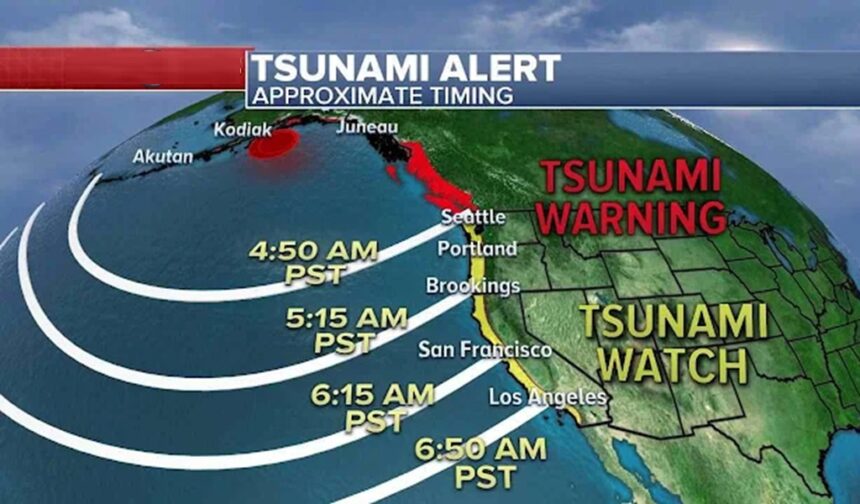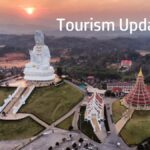HAWAII – On Wednesday morning, July 30, 2025, a massive 8.8 earthquake struck off Russia’s Kamchatka Peninsula, sparking tsunami warnings across the Pacific. The U.S. National Weather Service Tsunami Warning System quickly issued alerts covering the U.S. West Coast, coastal British Columbia, Hawaii, and Japan.
Advisories also went out to regions including Guam, the Philippines, and other Pacific areas.
This earthquake, among the world’s strongest since the 2011 Tohoku disaster in Japan, left many worried about damaging waves reaching far-off coasts.
The U.S. Geological Survey reported the earthquake’s epicentre about 85 miles east of Petropavlovsk-Kamchatsky at a depth of 12 miles. Initial reports set the magnitude at 8.0, later raised to 8.8, placing it among the six most powerful recorded.
Pacific Tsunami Warning Center
According to the Pacific Tsunami Warning Center, the quake generated a tsunami, and waves have already hit parts of Russia’s Kuril Islands and northern Japan. In Hawaii, officials warned waves could reach up to 9 feet, prompting urgent evacuations from coastal areas, including Honolulu.
The Pacific Tsunami Warning Center stated, “A tsunami has been generated that could cause damage along the coastlines of all Hawaii’s islands.” Residents heard sirens and moved to higher ground as the first waves were expected around 7:17 p.m. local time.
The National Weather Service pointed out that tsunamis can wrap around islands, so all shores faced risk. Some later waves could be higher than the first ones.
Japan’s Meteorological Agency issued warnings from Hokkaido down to Kyushu, with waves up to 3 metres (around 10 feet) expected. Early waves, about 30 centimetres high, hit Nemuro on Hokkaido’s east coast before 10:40 a.m. local time, as NHK reported.
Officials told residents in at-risk zones to head to higher ground or safe shelters right away. News footage from Kamaishi and Ishinomaki, both deeply affected by the 2011 tsunami, showed people leaving coastal areas.
The U.S. West Coast, from California to Washington, and parts of British Columbia also received tsunami advisories. Officials warned of strong currents and waves up to 5.7 feet in areas like Crescent City, California.
National Tsunami Warning Center
The National Tsunami Warning Center told residents to stay away from beaches, harbours, and marinas. While Cannon Beach in Oregon didn’t call for evacuation, local authorities asked people to stay alert. In coastal Oregon towns, the NWS said dangerous waves were likely between 11:40 p.m. and 11:50 p.m. local time.
The earthquake happened in the Pacific Ring of Fire, a zone with frequent earthquakes and volcanoes. This spot makes a damaging tsunami much more likely. Experts estimate more than an 80% chance of hazardous waves hitting coasts under warnings, based on the quake’s size, depth, and location. The USGS also noted that the shallow depth increased the tsunami risk. Aftershocks of 6.3 and 6.9 magnitudes followed, adding to the concern.
Reports from Kamchatka’s Yelizovo District mention waves of 3 to 4 metres. These caused minor damage to a kindergarten but no major injuries, according to local officials. Severo-Kurilsk on the Kuril Islands began evacuating after a tsunami threat was announced.
Power outages and problems with mobile networks were reported by Russia’s TASS news agency as people moved to safer ground.
Alerts reached beyond the Pacific’s usual warning zones. Ecuador, Chile, and the Solomon Islands could face waves of 1 to 3 metres.
Guam and American Samoa
New Zealand’s emergency management urged caution, warning about strong, unusual currents along its coast. Guam and American Samoa are under official advisories, with forecasts suggesting waves between 1 and 3 feet.
The USGS said damages from the earthquake alone could reach into the billions, giving it a rare “red pager” alert for destructive potential. With coastal regions bracing for impact, authorities across the Pacific are urging everyone to follow evacuation orders and stay up to date. The National Weather Service stressed that the risk lasts for many hours after the initial waves and that conditions remain unpredictable.
For the latest updates, people are encouraged to check tsunami.gov for real-time information. As the situation unfolds, emergency agencies remind communities to act quickly and remain prepared for further developments.
Sources: U.S. National Weather Service, U.S. Geological Survey, Japan Meteorological Agency, Pacific Tsunami Warning Center














